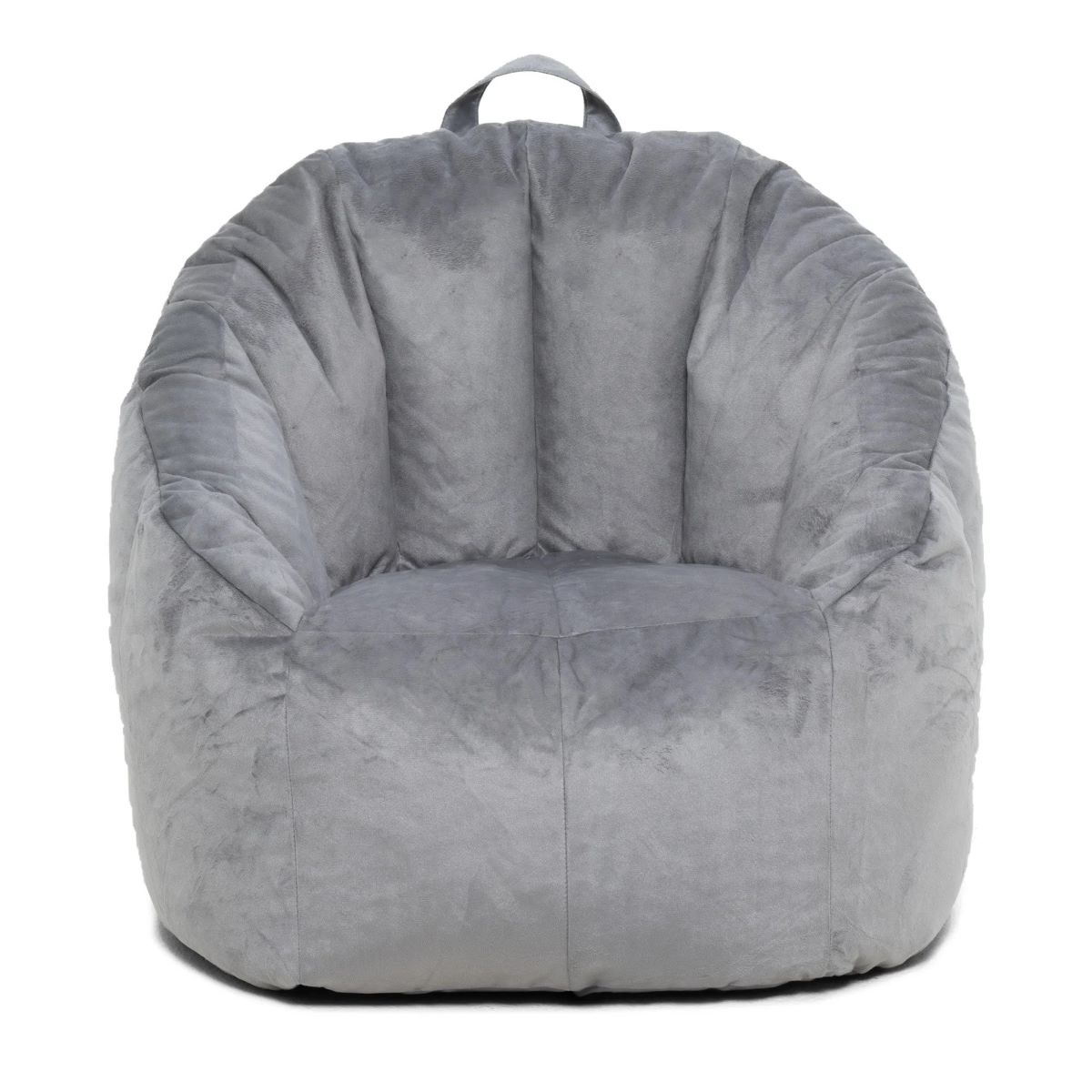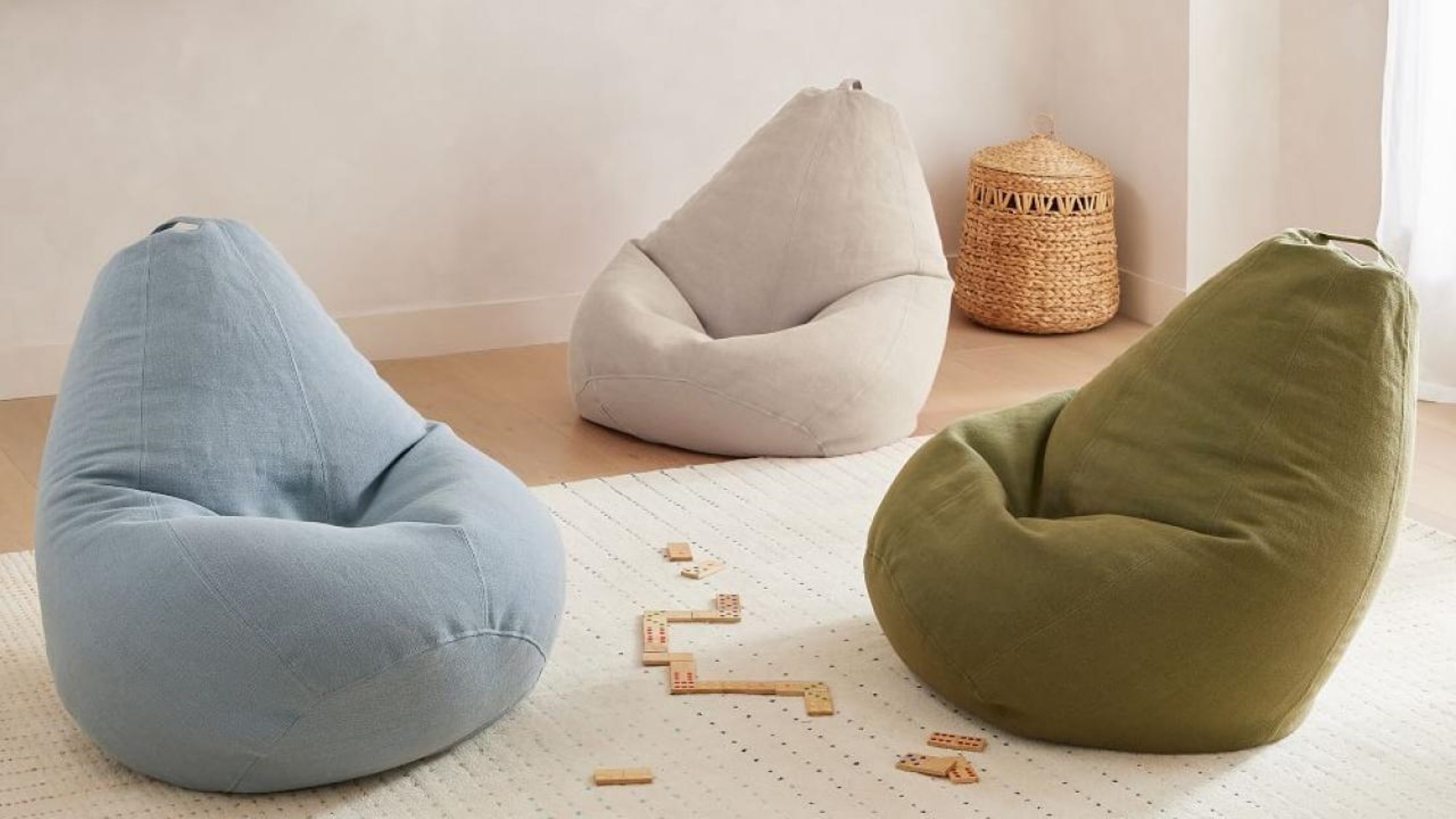Home>Furniture>Living Room Furniture>How To Fix A Bean Bag Chair


Living Room Furniture
How To Fix A Bean Bag Chair
Modified: March 16, 2024
Learn how to fix your bean bag chair and restore its comfort and style with our easy-to-follow guide. Find the best living room furniture solutions today!
(Many of the links in this article redirect to a specific reviewed product. Your purchase of these products through affiliate links helps to generate commission for Storables.com, at no extra cost. Learn more)
Introduction
Welcome to this step-by-step guide on how to fix a bean bag chair. Bean bag chairs are a popular and comfortable addition to any living room or lounge area. However, over time, they can become worn out or damaged, losing their shape and support. Instead of replacing the entire chair, you can save money and extend its lifespan by repairing it yourself.
In this article, we will walk you through the process of fixing a bean bag chair, covering both small repairs and more extensive fixes. By following these steps, you can restore your bean bag chair to its former glory and continue to enjoy its cozy embrace.
Before we get started, it’s important to assess the type and extent of damage to your bean bag chair. This will help you determine the appropriate repair method and gather the necessary materials. So, let’s dive in and begin our journey to reviving your beloved bean bag chair!
Key Takeaways:
- You can save money and extend the life of your bean bag chair by fixing small tears with a repair kit or replacing larger damaged areas with matching fabric. Don’t forget to assess the filling and fluff it up for continued comfort!
- After following the step-by-step guide, you’ll have a fully functional and cozy bean bag chair. Regular maintenance, like keeping it clean and fluffing the filling, will help it last for many more years of relaxation.
Read more: What Is A Bean Bag Chair
Materials Needed
Before you begin repairing your bean bag chair, it’s essential to gather all the necessary materials. Having these items on hand will ensure a smooth and efficient repair process. Here are the materials you’ll need:
- Bean bag chair repair kit: These kits typically include patches, adhesive, and other tools specifically designed for repairing bean bag chairs. You can find them at your local home improvement store or purchase them online.
- Fabric or vinyl matching your chair: If your chair has a significant tear or hole, you may need to replace the damaged section with a matching fabric or vinyl. Be sure to choose a material that closely resembles the original upholstery to maintain a cohesive look.
- Scissors: A pair of sharp scissors will be necessary for cutting fabric or trimming threads during the repair process.
- Measuring tape: You’ll need a measuring tape to accurately measure the dimensions of the damaged area or the replacement fabric.
- Marker or fabric chalk: A marker or fabric chalk will come in handy when marking the areas that need to be repaired or cut.
- Sewing machine and thread: If you’re replacing a large section of your bean bag chair, a sewing machine and matching thread will be needed for sewing the new fabric in place. Alternatively, you can also hand-sew the fabric if you prefer.
- Zipper or Velcro (optional): If your bean bag chair has a removable cover, you may need a replacement zipper or Velcro fastening for reassembling the chair after the repair is complete.
- Bean bag filling: Depending on the condition of your chair’s filling, you may need to purchase additional bean bag filling. This is especially true if the chair has become flat or lacks support.
Having all these materials prepared will ensure that you have everything you need to successfully fix your bean bag chair. Now that you’re equipped let’s move on to the next step: assessing the damage.
Step 1: Assess the Damage
The first step in repairing your bean bag chair is assessing the extent of the damage. Take a close look at the chair and identify any tears, holes, or areas where the stitching has come undone. This assessment will help you determine the appropriate repair method to use.
If you notice small tears or holes in the fabric, you can often fix them using patches and adhesive from a bean bag chair repair kit. These kits typically include self-adhesive patches that you can cut to the desired size and place over the damaged area. Follow the instructions provided with the kit to ensure proper application.
For larger rips or tears, you may need to consider replacing the damaged section of the fabric. This will require matching fabric or vinyl that closely resembles the original upholstery. Measure the size of the damaged area and cut a corresponding piece of fabric or vinyl, leaving a border for sewing or adhering the new piece in place.
An important factor to consider during the assessment is the condition of the bean bag filling. If the chair has lost its shape or support, you may need to replace the filling entirely or add more filling to restore its plumpness. Assess if the filling feels lumpy, flat, or uneven, which may indicate the need for additional filling.
By thoroughly assessing the damage, you will have a clear understanding of the repairs needed and be better prepared for the next steps. Now, let’s move on to gathering the necessary supplies for the repair process.
Step 2: Gather the Necessary Supplies
After assessing the damage to your bean bag chair, it’s time to gather all the necessary supplies for the repair process. By having everything you need on hand, you can work efficiently and complete the repairs successfully. Here are the supplies you’ll need:
- Bean bag chair repair kit: If you haven’t already purchased a repair kit, now is the time to do so. These kits typically include patches, adhesive, and other tools needed for repairing small tears or holes in bean bag chairs.
- Matching fabric or vinyl: If your chair has larger rips or tears that cannot be repaired with a patch, you’ll need matching fabric or vinyl to replace the damaged section. Choose a material that closely matches the original upholstery to maintain a cohesive look.
- Scissors: A pair of sharp scissors will be necessary for cutting fabric, trimming threads, and making precise cuts during the repair process.
- Measuring tape: A measuring tape will help you accurately measure the dimensions of the damaged area or the replacement fabric you need to cut.
- Marker or fabric chalk: Use a marker or fabric chalk to mark the areas that need to be repaired or cut. This will ensure precision and accuracy throughout the repair process.
- Sewing machine and thread: If you’re replacing a large section of the bean bag chair, a sewing machine and matching thread will be essential for sewing the new fabric in place. Alternatively, you can hand-sew the fabric if you prefer.
- Zipper or Velcro (if applicable): If your bean bag chair has a removable cover, check if the zipper or Velcro fastening needs replacing. Make sure you have a replacement zipper or Velcro on hand if necessary.
- Bean bag filling: Assess the condition of the chair’s filling. If it has become flat or lacks support, you may need to purchase additional bean bag filling to restore its plumpness.
Gathering all these supplies before you start the repair process will save you time and minimize interruptions. Now that you have everything you need, you’re ready to move on to the next step: repairing small tears or holes in your bean bag chair.
Step 3: Repair Small Tears or Holes
Once you have gathered all the necessary supplies, it’s time to start repairing the small tears or holes in your bean bag chair. Follow these steps to fix the damage:
- Clean the area: Before applying any patches or adhesive, clean the damaged area of the chair with a damp cloth to remove any dirt or debris. This will ensure better adhesion and a more secure repair.
- Cut the patch: Take a patch from your bean bag chair repair kit or cut a piece of matching fabric slightly larger than the tear or hole. Round the corners of the patch to prevent them from peeling over time.
- Stick the patch: Apply a layer of adhesive to the back of the patch or use the pre-adhesive patch provided in the repair kit. Carefully place the patch over the damaged area, making sure to smooth out any wrinkles or bubbles. Press down firmly to ensure proper adhesion.
- Let it dry: Allow the adhesive to dry according to the instructions provided with the repair kit. This usually takes a few hours, but it’s best to wait overnight to ensure a strong bond.
- Trim excess: Once the adhesive has dried, use scissors to trim any excess patch material that extends beyond the edges of the repaired area. This will give your repair a neat and seamless appearance.
- Inspect and test: After completing the repair, carefully inspect the area to ensure the patch is securely attached and there are no loose edges. Test the repaired area by gently pressing on it to ensure it is sturdy and well-fixed.
By following these steps, you can effectively repair small tears or holes in your bean bag chair. Remember to read and follow the instructions provided with your repair kit for the best results. Now, let’s move on to the next step: fixing large rips or tears.
To fix a bean bag chair, first identify the damaged area. Then, use a needle and thread to sew up any holes or tears. For larger tears, use a patch or fabric glue to reinforce the area.
Read more: How To Store A Bean Bag Chair
Step 4: Fixing Large Rips or Tears
If your bean bag chair has larger rips or tears that cannot be fixed with a patch, you will need to replace the damaged section of fabric. Follow these steps to fix large rips or tears:
- Measure and mark the damaged area: Use a measuring tape to determine the size of the damaged section. Mark the area that needs to be replaced on the fabric or vinyl, making sure to leave a border of about 1 inch (2.5 cm) around the marked area.
- Cut out the damaged section: Carefully cut out the marked section using sharp scissors or a fabric cutter. Be precise and follow the marked lines to ensure a clean cut.
- Cut the replacement fabric: Using the measurements of the removed section as a guide, cut a piece of matching fabric or vinyl to replace the damaged area. Make sure the replacement fabric is slightly larger than the cut-out section.
- Sew or adhere the replacement fabric: If you have a sewing machine, sew the replacement fabric onto the bean bag chair. Use a matching thread and a straight stitch to secure the fabric in place, leaving a seam allowance of approximately 1/2 inch (1.27 cm). Alternatively, you can use adhesive from a bean bag chair repair kit to adhere the replacement fabric to the chair. Follow the instructions provided for the best results.
- Trim excess fabric: Once the replacement fabric is securely attached, trim any excess material that extends beyond the seam or edges. This will give the repair a neat and tidy finish.
- Inspect the repair: Carefully inspect the repaired area to ensure that the replacement fabric is securely attached and there are no loose edges or wrinkles. Test the repaired section by applying gentle pressure to ensure it is sturdy and well-fixed.
By following these steps, you can effectively fix large rips or tears in your bean bag chair. The key is to take your time, be precise with your measurements and cuts, and ensure that the replacement fabric matches the original upholstery. Now, let’s move on to the next step: replacing the inner filling of the bean bag chair.
Step 5: Replacing the Inner Filling
Over time, the filling of your bean bag chair may flatten or lose its shape, reducing the comfort and support it provides. To restore your chair’s plumpness and fluffiness, you may need to replace the inner filling. Here’s how to do it:
- Empty the chair: Find a large, empty space where you can empty the contents of your bean bag chair. Open the zipper or fastening mechanism to release the filling. Be careful not to spill it all over the place – a controlled emptying process is recommended.
- Assess the condition: Evaluate the condition of the existing filling. If it is still in good shape and only needs a refresh, you may be able to fluff it up by hand. Shake and knead the filling to distribute it evenly and restore its shape. However, if the filling is flat, lumpy, or deteriorated, it is best to replace it entirely.
- Measure the replacement filling: Determine the amount of replacement filling you will need for your chair. Refer to the manufacturer’s guidelines or the original filling quantity as a reference. Bean bag filling is usually sold by volume or weight, so measure accordingly.
- Insert the new filling: Carefully pour the replacement filling into the bean bag chair. Start by filling the bottom to create a stable base, then gradually add the filling to achieve the desired level of comfort. Avoid overfilling, as it may affect the chair’s shape and comfort.
- Distribute the filling: Once the new filling is in place, distribute it evenly throughout the chair. This can be done by shaking, fluffing, and gently pressing on different areas of the chair to ensure an even distribution of the filling. This will help the chair maintain its shape and provide optimal comfort.
- Close the chair: Once you are satisfied with the filling distribution, carefully close the zipper or fastening mechanism of the bean bag chair. Ensure that it is securely fastened to prevent any spillage or leakage of the filling.
By following these steps, you can replace the inner filling of your bean bag chair and restore its plumpness and comfort. Remember to choose high-quality filling materials that are designed for bean bag chairs for the best results. Now, let’s move on to the final step: reassembling the bean bag chair.
Step 6: Reassembling the Bean Bag Chair
After completing the necessary repairs and replacements, it’s time to reassemble your bean bag chair. Follow these steps to ensure a proper reassembly:
- Inspect the repaired areas: Take a moment to thoroughly inspect the repaired sections of your bean bag chair. Ensure that all patches are securely attached, seams are intact, and any replaced fabric is seamless and blends well with the rest of the chair.
- Check the zipper or fastening mechanism: If your bean bag chair has a removable cover, check the condition of the zipper or fastening mechanism. Replace or repair it if necessary to ensure that the cover fits securely and can be easily removed for cleaning or maintenance.
- Insert the filling: If you replaced the inner filling of your bean bag chair, double-check that the filling is evenly distributed and properly fluffed. Make any necessary adjustments to ensure optimal comfort and support.
- Close the chair: Carefully close the zipper or fastening mechanism of the bean bag chair. Ensure that it is securely fastened to prevent any spillage or leakage of the filling.
- Test the chair: Give your bean bag chair a gentle shake and sit on it to test its comfort and stability. Make sure that it retains its shape and provides adequate support. If needed, adjust the filling or make any final tweaks to achieve the desired level of comfort.
Once you have reassembled the bean bag chair and confirmed that everything is in order, you can sit back, relax, and enjoy your repaired and refreshed piece of furniture. It’s a great feeling to know that you have successfully extended the lifespan of your bean bag chair through DIY repairs!
Remember, regular maintenance and care can help prolong the life of your bean bag chair. Keep it clean, avoid placing it in direct sunlight or high-heat areas, and periodically fluff the filling to maintain its shape and comfort. With proper care, your bean bag chair will continue to provide cozy relaxation for years to come.
Congratulations on completing the repair process! You should now have a fully functional and comfortable bean bag chair ready for use. Enjoy the comfort and satisfaction of knowing that you successfully fixed and rejuvenated your beloved piece of furniture.
Conclusion
Congratulations on successfully repairing your bean bag chair! By following the step-by-step guide provided in this article, you have saved money and extended the lifespan of your beloved piece of furniture. Whether you fixed small tears and holes or tackled larger rips and replaced the inner filling, your bean bag chair is now ready to provide you with many more hours of comfort and relaxation.
Remember, the key to a successful repair is taking your time, being meticulous in your measurements and cuts, and using the right materials. Whether you used patches and adhesive or replaced sections of fabric, the goal was to restore the chair’s functionality and aesthetic appeal. By doing so, you have not only saved money but also contributed to a more sustainable approach to furniture maintenance.
Regular maintenance and care will help preserve your repaired bean bag chair for years to come. Keep it clean, avoid placing it in high-heat areas, and periodically fluff the filling to maintain its shape and support. Following these simple steps will keep your bean bag chair in excellent condition and provide you with continued comfort and relaxation.
We hope this comprehensive guide has been helpful to you in fixing your bean bag chair. Remember, repairing furniture can be a rewarding and creative endeavor. By putting your DIY skills to work, you not only save money but also develop a deeper appreciation for the items in your home.
Thank you for embarking on this repair journey with us. We wish you many more cozy moments and relaxing experiences with your newly repaired bean bag chair!
Frequently Asked Questions about How To Fix A Bean Bag Chair
Was this page helpful?
At Storables.com, we guarantee accurate and reliable information. Our content, validated by Expert Board Contributors, is crafted following stringent Editorial Policies. We're committed to providing you with well-researched, expert-backed insights for all your informational needs.















0 thoughts on “How To Fix A Bean Bag Chair”